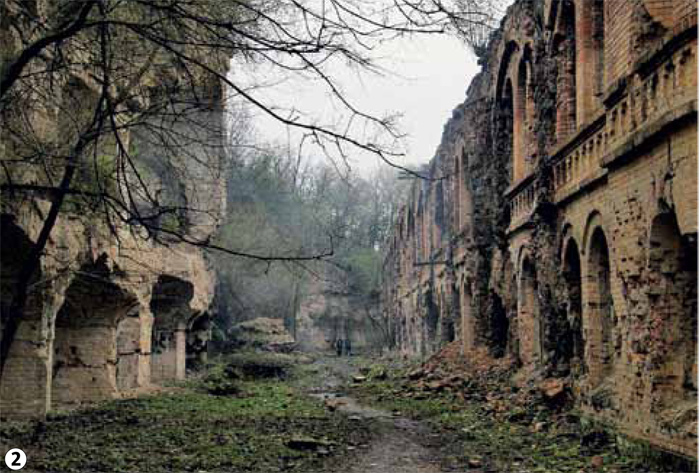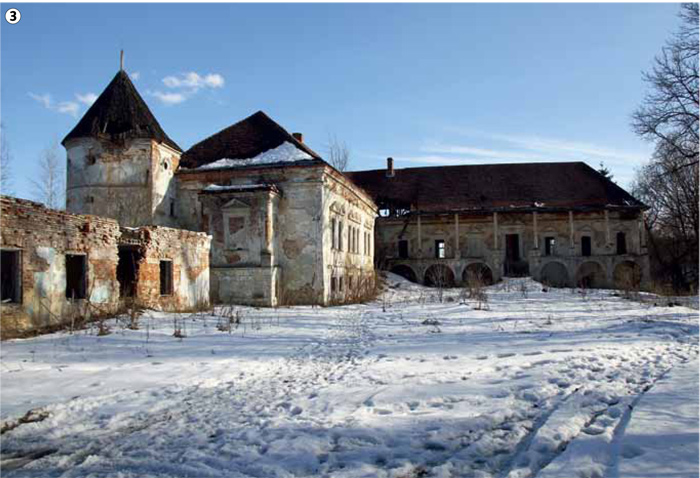Ukraine’s castles and fortresses, which for many years were little known to the public at large, have recently become an integral part of many tourist routes, through the efforts of journalists, regional ethnologists and enthusiasts. However, there are several architectural treasures that are traditionally promoted by those who popularize Ukrainian history. For example, the fortress in Kamianets-Podilsky, as well as the Pidhoretsky and Olesko castles have blinded tourists to other, no less deserving architectural attractions. The Ukrainian Week highlights several less photogenic but equally notable ancient fortifications in Ukraine.

THE OLD VILLAGE CASTLE
The fortress at Stare Selo (Old Village), some 20 km southeast of Lviv, is a unique construction despite its neglected condition. It is not only Galicia’s biggest fortress in terms of territory (around two hectares) but also one of the biggest in Ukraine. This giant castle, which has seen better times, is truly worth seeing, if only because of its size. Moreover, just like any other historical monument, it hides countless, almost cinematographic episodes of its past: bloody wars and assaults, intrigues, rebellions and legends. Bohdan Khmelnytsky’s Cossack and Tatar units refused to storm the fortress during the national liberation struggle in 1654, and a big Turkish army failed to take it in 1672. Rumour has it that a fortunate occurrence helped drive away the invincible Turkish army: one of the defenders shot dead a Turkish military commander, which the invaders took as an ill omen.

The exact construction date of the fortress is not known. Most researchers believe it was built in 1584-89 on the commission of the Ostrozky princes, under the management of Italian architect Ambrosiy Prykhylny. The latter went on to construct the Bernardine Church and Monastery, one of Lviv’s most remarkable architectural monuments. According to this version, the castle was renovated in 1642, while an alternative view is that this is the actual year of construction, rather than reconstruction. In 1731, Stare Selo became the property of the Czartoryskis, who were Polish magnates. It was during this time that the owners left the formerly formidable fortification to its fate and ultimate decline. In 1809, Izabela Czartoryska gave the castle as a gift to her grandsons, the Potocki magnates, who used it for household needs. It is known that the last owner, Alfred Potocki, set up a brewery there and left it for good in September 1939.
READ ALSO: Tour de Ukraine
This treasure of defensive architecture in Stare Selo is now in a state of bad repair. In 2010, a concession to use it for 49 years was issued, and the concessionaire pledged to repair the castle by 2012. Ideally, it was to have accommodated a tourist-arts centre. However, the project is still on paper only and no actual work has been done.
THE TARAKANIV FORT
In recent years, the half-ruined Tarakaniv Fort (photo 2) in Rivne Oblast has become known throughout Ukraine. One after another, tourists who dared to spend the night in this rather creepy place, asserted that the bleak dungeons and numerous labyrinths of the fortification literally came alive, becoming filled with semi-transparent figures dressed in military uniforms. Moreover, researchers confirmed the existence of a powerful energetic force coming from some unknown source in the fort. Electrical appliances often break down in the underground premises.
But let us leave these reports for those who love all things psychic. We are interested in the history of the fort, rather than in mystical stories. In the late 18th century, after another division of Poland, the border between the Austrian and Russian empires was drawn to cut through these lands. In the mid-19th century, the tsarist government decided to fortify its western frontiers and launched the construction of a system of defence fortifications which was also to include the Tarakaniv Fort.

Vast sums were spent on the project over several decades, but the fort did not prove to be efficient as a military facility and was already outdated prior to the completion of construction in 1890. It was first tested in the First World War. Initially, the Russian Army surrendered it without a fight and the fort remained intact. It suffered damage later, during the Brusilov offensive, when Russian units drove the Austrians out of the fortification, with both sides suffering heavy casualties. During the Second World War, the fort with its numerous buildings was used for storage by both the German and the Russian army. The fort finally became deserted after the war.
READ ALSO: Noble Walls
Local old-timers tell many interesting things about the final chapter of the fort’s history. Supposedly all of the locals are familiar with the story of two dozen NKVD officers who disappeared without a trace in the fort. Following the incident, the Soviet command ordered the lowest levels of the fortification to be sealed with a 1.5m thick layer of concrete. Two daredevils recently decided to examine the dark labyrinths of the fort’s dungeons after which they ended up is a psychiatric hospital.
However, these things that you would expect to scare off tourists had the opposite effect: the fort became a true Mecca for those who love extreme forms of recreation and the rush of adrenaline.
THE POMORIANY CASTLE
Looking at this building – neglected, but nontheless elegant – which is living out its last years, it is hard to believe that it used to accommodate what was probably the biggest collection of European art in Galicia, including works by Leonardo da Vinci and Rembrandt. For centuries, this building, the Pomoriany Castle (photo 3), has maintained the status of a cult object for Poles and was once the favourite residence of Polish King John III Sobieski, and its walls were considered the strongest and the most reliable in the state.

When arriving at the village of Pomoriany, the few travellers who venture to travel the poor roads to reach this corner of Ukraine will not find anything that is reminiscent of the old days, when the Galician town was in its prime.
It all began in the mid-14th century when a wooden fortification was constructed on a hill overlooking the Zolota Lypa River, on the orders of a local voivode (a governor in ancient Russia or a military commander). It was later turned into an outpost, which protected the locals from Turkish and Tatar attacks. After their raids, the new owners of the castle, the Sienieński family, had it restored and fortified. In spite of its widely reported unassailability, the castle was damaged many times. Jerzy Potocki was the last owner, leaving these lands in 1939 when the Soviets moved into Galicia.
READ ALSO: Solomia’s Solo
The current condition of the castle is dreadful. In 2011, a wall fell down, and the locals literally took it apart. In 2010, the brick wall and the iron gate disappeared. Lviv Oblast officials have said on many occasions that a concession needs to be granted to this monument, but the story of the Stare Selo Fortress proves that this is not a solution to the problem.
This monument is worth seeing, while there is still something to see. No legend, story or historical chronicle can create the true effect of presence, only an artificial and emotionless one. Such places need to be experienced in the here-and-now fashion, preferably at the end of the day, when twilight begins to descend on the ancient walls. At these moments, it is possible to feel the physical presence of time, as it flows through us and quietly enters the dark corridors of the castle.

